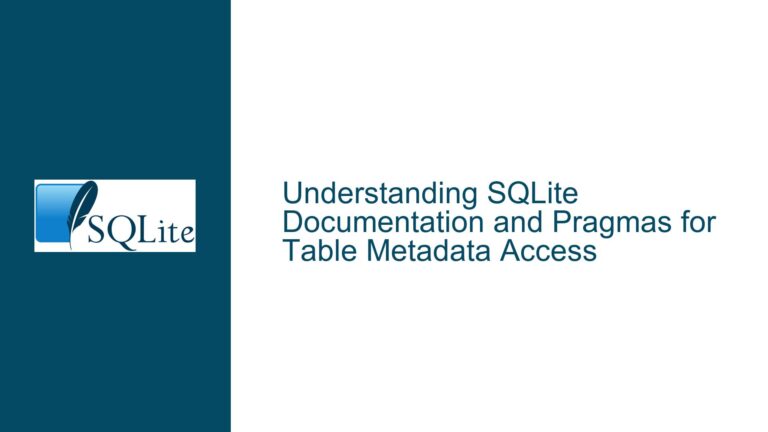Troubleshooting FOREIGN KEY Constraint Violation in SQLite with Tcl onecolumn Command
Issue Overview: FOREIGN KEY Constraint Violation in SQLite with Tcl onecolumn Command
The core issue revolves around the behavior of the SQLite Tcl interface, specifically the onecolumn command, when handling FOREIGN KEY constraint violations. In the provided scenario, a FOREIGN KEY constraint is defined on the trades table, referencing the id column in the items table. The onecolumn command is used to execute an INSERT statement that violates this constraint, but no error is raised. However, when the same INSERT statement is executed using the eval command, the FOREIGN KEY constraint violation is correctly detected, and an error is raised.
The onecolumn command in SQLite’s Tcl interface is designed to execute a SQL statement and return the first column of the first row of the result set. If the SQL statement does not return any rows, onecolumn returns an empty string. This behavior is consistent with the command’s purpose, which is to simplify the retrieval of single values from the database. However, the command’s handling of constraint violations, particularly FOREIGN KEY constraints, appears to be inconsistent with the behavior of other SQLite commands, such as eval.
The inconsistency arises because the onecolumn command does not propagate constraint violation errors in the same way that eval does. When onecolumn is used to execute an INSERT statement that violates a FOREIGN KEY constraint, the command silently ignores the violation and returns the value that would have been inserted if the constraint had not been violated. This behavior can lead to confusion and potential data integrity issues, as the user may be unaware that the constraint was violated and that the data was not actually inserted into the database.
Possible Causes: Misalignment Between onecolumn Command and SQLite Constraint Enforcement
The root cause of this issue lies in the way the onecolumn command interacts with SQLite’s constraint enforcement mechanisms. SQLite enforces constraints at the database level, ensuring that all operations comply with the defined rules, such as FOREIGN KEY constraints. When a constraint is violated, SQLite typically raises an error and prevents the operation from completing. However, the onecolumn command appears to bypass this enforcement mechanism, allowing the operation to proceed despite the constraint violation.
One possible explanation for this behavior is that the onecolumn command is designed to prioritize the retrieval of a single value over the enforcement of constraints. This design choice may have been made to simplify the use of the command in scenarios where the user is only interested in the result of the operation and not in the underlying constraints. However, this approach can lead to unexpected behavior, particularly when the command is used in contexts where constraint enforcement is critical.
Another possible cause is a bug or oversight in the implementation of the onecolumn command. It is possible that the command does not properly check for constraint violations before returning the result of the operation. This could be due to a lack of error handling code or an incorrect assumption about the behavior of the underlying SQLite engine. In either case, the result is that the command fails to raise an error when a constraint is violated, leading to the observed inconsistency.
Troubleshooting Steps, Solutions & Fixes: Ensuring Consistent Constraint Enforcement with onecolumn Command
To address this issue, it is important to understand the behavior of the onecolumn command and how it interacts with SQLite’s constraint enforcement mechanisms. The following steps outline a systematic approach to troubleshooting and resolving the issue:
Verify the FOREIGN KEY Constraint Definition: The first step is to ensure that the FOREIGN KEY constraint is correctly defined in the database schema. In the provided scenario, the
tradestable has a FOREIGN KEY constraint that references theidcolumn in theitemstable. This constraint should be enforced by SQLite whenever anINSERToperation is performed on thetradestable. To verify the constraint, you can use thePRAGMA foreign_key_checkcommand, which checks the integrity of FOREIGN KEY constraints in the database. If the constraint is not correctly defined, you may need to recreate the table with the correct constraint.Test the Constraint Enforcement with Different Commands: Next, you should test the enforcement of the FOREIGN KEY constraint using different SQLite commands, such as
evalandonecolumn. This will help you confirm whether the issue is specific to theonecolumncommand or if it affects other commands as well. In the provided scenario, theevalcommand correctly raises an error when the FOREIGN KEY constraint is violated, while theonecolumncommand does not. This suggests that the issue is specific to theonecolumncommand.Examine the Implementation of the onecolumn Command: To understand why the
onecolumncommand does not raise an error when the FOREIGN KEY constraint is violated, you should examine the implementation of the command in the SQLite Tcl interface. The source code for the command can be found in the SQLite source distribution, typically in thesrc/tclsqlite.cfile. Look for the section of the code that handles the execution of SQL statements and the retrieval of results. Pay particular attention to how the command handles errors and constraint violations.Modify the onecolumn Command to Enforce Constraints: If the issue is due to a lack of error handling in the
onecolumncommand, you may need to modify the command to ensure that it properly checks for constraint violations before returning the result of the operation. This could involve adding code to explicitly check for errors after executing the SQL statement and raising an error if a constraint violation is detected. Alternatively, you could modify the command to use theevalcommand internally, which already enforces constraints correctly.Use Alternative Commands for Constraint Enforcement: If modifying the
onecolumncommand is not feasible, you can use alternative commands to enforce constraints. For example, you can use theevalcommand to execute theINSERTstatement and then use theonecolumncommand to retrieve the result if needed. This approach ensures that the constraint is enforced correctly while still allowing you to retrieve a single value from the result set. Alternatively, you can use theexeccommand, which raises an error if the SQL statement fails, including when a constraint is violated.Implement Custom Error Handling: If you need to use the
onecolumncommand but still want to enforce constraints, you can implement custom error handling in your Tcl script. This involves executing the SQL statement using theevalcommand and checking for errors before using theonecolumncommand to retrieve the result. If an error is detected, you can handle it appropriately, such as by logging the error or rolling back the transaction. This approach provides greater control over how constraint violations are handled and ensures that the integrity of the database is maintained.Report the Issue to the SQLite Development Team: If you believe that the behavior of the
onecolumncommand is a bug or oversight, you should report the issue to the SQLite development team. Provide a detailed description of the issue, including the steps to reproduce it and any relevant code or schema definitions. The development team may be able to address the issue in a future release of SQLite, or they may provide guidance on how to work around the issue in the meantime.Consider Using a Different Database Interface: If the issue with the
onecolumncommand is causing significant problems in your application, you may want to consider using a different database interface that provides more consistent behavior with respect to constraint enforcement. For example, you could use the SQLite C API directly or switch to a different Tcl database interface that better meets your needs. While this approach may require more effort to implement, it can provide greater control over how constraints are enforced and how errors are handled.
In conclusion, the issue with the onecolumn command in SQLite’s Tcl interface arises from its inconsistent handling of FOREIGN KEY constraint violations. By following the troubleshooting steps outlined above, you can identify the root cause of the issue and implement a solution that ensures consistent constraint enforcement. Whether you choose to modify the onecolumn command, use alternative commands, or implement custom error handling, the key is to ensure that the integrity of the database is maintained and that constraint violations are properly detected and handled.






